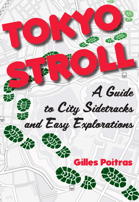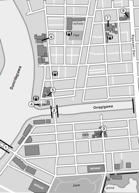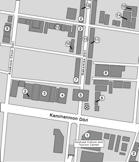











Tokyo Stroll Supplement: Itabashi ku

This page is for locations in the Itabashi ku area of Tokyo. This area is not part of my book Tokyo Stroll.
For information on Tokyo Stroll and this web supplement see Tokyo Stroll Supplement home page
For users of the Organic Maps, Maps.Me and Google Maps apps the items below have bookmarks you can import into those apps to make navigation easier.
Instructions and links are on the Viewing Locations in Organic Maps, Maps.Me, Google Maps, or Google Earth page.
Some entries on this page may include a note that says "Description to be added soon ." These entries are for items I felt should be listed even if the description is not ready to assist those who wish to plan a trip. When possible I included a link to an official web page, I suggest also doing web searchs for more information.
Itabashi ku (板橋区)
In 1932 Itabashi ku was formed by the merger of the nine towns and villages of Kita-Toshima District. In the Edo Period this area was the location of the first post town as one traveled to Kyoto from Edo on the Nakasendō.
Official pages for each of the ku of Tokyo will have sections of interest to visitors. These will likely be labeled as dealing with culture, tourism, or events.
Itabashi-ku official site: https://www.city.itabashi.tokyo.jp
Akatsuka Suwa Shrine / Akatsuka Suwa Jinja (赤塚諏訪神社)
Description to be added soon
NEAREST TRAIN/SUBWAY STATION: Takashimadaira Station (Toei Mita Line), Nishi-Takashimadaira Station (Toei Mita Line)
WEB: http://www.tokyo-jinjacho.or.jp/itabashi/3154/
An'yōin (安養院)
A Shingon sect temple founded by the Kamakura shōgunate regent Hōjō Tokiyori (1227-1263). The temple bell dates from the Edo Period. The main statue is of Amida Nyorai, crowned and seated on a peacock throne, is believed to have been carved in the early Edo Period. On March 30, 1990 this statue was designated an Itabashi Ward Designated Tangible Cultural Property (Historical Material). Another significant image is housed in a zushi, a type of as miniature shrine. This zushi contains a statue in the form of a mountain that includes a statue of Shākyamuni. The zushi and it's contents were the property of Takeda Shingen, it was handed down in the Kishū Tokugawa family and eventually donated to the temple. On March 30, 1990 this statue was also designated an Itabashi Ward Designated Tangible Cultural Property (Historical Material). The grounds also contain a large kaya tree which on March 13, 1995 was registered as an Itabashi Ward Registered Monument (Natural Monument).
PILGRIMAGE: This temple is on the Itabashi Shichifukujin Meguri route Benzaiten.
NEAREST TRAIN/SUBWAY STATION: Tokiwadai Station (Tōbu Tōjō Line)
Chōmeiji (長命寺)
A Toyoyama sect Shingon Buddhist temple, founded around 1652. Yakushi Nyorai is the main deity of the temple. In 1782 the main hall was remodeled, in 1919 and 1963 major repair were done.
This temple is on the Itabashi Shichifukujin Meguri route Fukurokuju.
NEAREST TRAIN/SUBWAY STATION: Naka-Itabashi Station (Tōbu Tōjō Line)
Happy Road Ōyama / Happīrōdo Ōyama shōten machi (ハッピーロード大山商店街)
This shōtengai, shopping street, originated after WWII from a mix of small shops, shacks, and stalls in this burned out section of Tokyo. At first the street was called Ōyama Ginza, the name was changed to Happy Road in 1977 by the newly established merchants union. In 1996 the arcade roof was repaired or replaced in parts. This shōtengai is half a kilometer long with over 200 shops. mostly locally owned and many run by the third and fourth generations since the shop was established. The stores mainly serve the needs of the local population as this is not a tourist hotspot. There are lots of food options from restaurants to small to go items available at butcher shops and bakeries.
CLOSED: Many shops are closed on Tuesdays, some are closed on Mondays
NEAREST TRAIN/SUBWAY STATION: Ōyama Station (Tōbu Tōjō Line)
WEB: https://haro.or.jp
Itabashi Art Museum / Itabashi Kuritsu Bijutsukan (板橋区立美術館)
Description to be added soon
NEAREST TRAIN/SUBWAY STATION: Takashimadaira Station (Toei Mita Line), Nishi-Takashimadaira Station (Toei Mita Line)
WEB: https://www.city.itabashi.tokyo.jp/artmuseum/
Itabashi Historical Museum / Itabashi Kuritsu Kyōdo Shiryōkan (板橋区立郷土資料館)
Description to be added soon
NEAREST TRAIN/SUBWAY STATION: Takashimadaira Station (Toei Mita Line), Nishi-Takashimadaira Station (Toei Mita Line)
WEB: https://www.city.itabashi.tokyo.jp/kyodoshiryokan/
Jōrenji (乗蓮寺)
Description to be added soon
NEAREST TRAIN/SUBWAY STATION: Takashimadaira Station (Toei Mita Line), Nishi-Takashimadaira Station (Toei Mita Line)<
WEB: http://www.tokyo-daibutsu.com
Kanmyōji (観明寺)
A Shingon sect temple believed to have been founded during the Muromachi period. A standing statue of Sho Kannon dating from the 12th century is the main image.
The grounds include an inari shrine that had originally been on the grounds of the Kaga han residence, there is also a kōshin tower from 1661 which is a Tangible Cultural Property of Itabashi ku and a Fudō statue that is a hidden Buddha.
PILGRIMAGE: This temple is on the Itabashi Shichifukujin Meguri route Ebisu.
NEAREST TRAIN/SUBWAY STATION: Itabashi-kuyakushomae Station (Toei Mita Line)
Monjuin (文殊院)
Founded as a Shingon temple in the Kanbun era (1661-1673), This was the family temple of the Iida family, who held the office of Itabashi-juku Honjin in the Edo Period. A honjin is a special inn for government officials. The temple contain a seated statue of Manjusri Bodhisattvā, the statue is a hidden buddha and is not displayed to the public. There is also an impressive statue of Enma the judge of the dead.
PILGRIMAGE: This temple is on the Itabashi Shichifukujin Meguri route Bishamonten.
NEAREST TRAIN/SUBWAY STATION: Itabashi-kuyakushomae Station (Toei Mita Line)
Saikōji (西光寺)
A Shingon temple dating from the Edo Period. The Shirokaki Jizō on the temple grounds is believed to date from the Muromachi Period and is the oldest Jizō statue in Itabashi Ku. The statue is of a seated Jizō in a small wooden structure. It was moved to Saikōji from its original location at Hikawa Shrine during WWII. A legend says that a local farmer was having trouble tilling his field. A young monk passing by remarked that it looked like hard work. The next morning the farmer went out to find his field fully tilled, and the lower half of the local Jizō statue was covered in mud. In 1986 the statue was registered as a Itabashi Ward Registered Tangible Folk Cultural Property.
PILGRIMAGE: This temple is on the Itabashi Shichifukujin Meguri route Hōtei.
ACCESS: The entrance is to the south.
NEAREST TRAIN/SUBWAY STATION: Senkawa Station (Fukutoshin Line, Yūrakuchō Line) or Kotake-mukaihara Station (Fukutoshin Line, Seibu Yūrakuchō Line, Yūrakuchō Line)
Saya No Yudokoro(さやの湯処)
Description to be added soon
An onsen.
NEAREST TRAIN STATION: Shimura-sanchome Station (Toei Mita Line), Motohasunuma Station (Toei Mita Line)
WEB: https://www.sayanoyudokoro.co.jp
Seikōin (西光院)
PILGRIMAGE: This temple is on the Itabashi Shichifukujin Meguri route Daikokuten
NEAREST TRAIN/SUBWAY STATION: Ōyama Station (Tobu Tōjō Line), Kanamechō Station (Yūrakuchō Line and Fukutoshin Line)
Tokumaru Kitano Shrine / Tokumaru Kitano Jinja (徳丸北野神社)
Description to be added soon
NEAREST TRAIN/SUBWAY STATION: Takashimadaira Station (Toei Mita Line), Nishi-Takashimadaira Station (Toei Mita Line), Tōbu-Nerima Station (Tōbu Tōjō Line)
WEB: https://tokumarutenjin-kitanojinja.jimdofree.com
Back to the Tokyo Stroll Supplement home page - Privacy Notice - Back to Gilles' home page
Created May 28, 2024 | Content last updated October 10, 2025